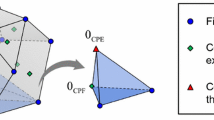Abstract
This work presents a linear smoothing scheme over high-order triangular elements within the framework of the cell-based strain smoothed finite element method for two-dimensional nonlinear problems. The main idea behind the proposed linear smoothing scheme is that it unlike the classical SFEM, it does not require the subdivision of the finite element cells into smoothing sub-cell. The other features of the classical SFEM are retained, such as: it does not require an explicit form of the derivatives of the basis functions, all the computations are done in the physical space, and the results are less sensitive to mesh distortion. A series of benchmark tests are done to demonstrate the validity and the stability of the proposed scheme. The validity and accuracy are confirmed by comparing the obtained numerical results with the standard FEM using quadratic triangular element and the exact solutions.












Similar content being viewed by others
References
Liu, G.R., Dai, K.Y., Nguyen, T.T.: A smoothed finite element method for mechanics problems. Comput. Mech. 39, 859–877 (2007)
Liu, G.R., Nguyen, T.T., Dai, K.Y., Lam, K.Y.: Theoretical aspects of the smoothed finite element method (SFEM). Int. J. Numer. Methods Eng. 71, 902–930 (2007)
Liu, G.R., Nguyen, T.T.: Smoothed Finite Element Method. CRC Press, Boca Laton (2010)
Nguyen-Xuan, H., Rabczuk, T., Bordas, S.P.A., Debongnie, J.: A smoothed finite element method for plate analysis. Comput. Methods Appl. Mech. Eng. 74, 175–208 (2008)
Nguyen-Thanh, N., Rabczuk, T., Nguyen-Xuan, H., Bordas, S.P.A.: A smoothed finite element method for shell analysis. Comput. Methods Appl. Mech. Eng. 198, 165–177 (2008)
Lee, C.K., Angela Mihai, L., Hale, J.S., Kerfriden, P., Bordas, S.P.A.: Strain smoothing for compressible and nearly-compressible finite elasticity. Comput. Struct. 182, 540–555 (2017)
Ong, T.H., Heaney, C., Lee, C.K., Liu, G.R., Nguyen-Xuan, H.: On stability, convergence and accuracy of bES-FEM and bFS-FEM for nearly incompressible elasticity. Comput. Methods Appl. Mech. Eng. 285, 315–345 (2014)
Bordas, S.P.A., Natarajan, S., Kerfriden, P., Augarde, C., Roy Mahapatra, D., Rabczuk, T., Dal Pont, S.: On the performance of strain smoothing for quadratic and enriched finite element approximations (XFEM/GFEM/PUFEM). Int. J. Numer. Methods Eng. 86, 637–666 (2011)
Bordas, S.P.A., Rabczuk, T., Nugyen-Xuan, H., Nguyen, V.P., Natarajan, S., Bog, T., Quan, D.M., Hiep, N.V.: Strain smoothing in FEM and XFEM. Comput. Struct. 88, 1419–1443 (2010)
Jiang, C., Zhang, Z.Q., Hang, X., Liu, G.R.: Selective smoothed finite element methods for extremely large deformation of anisotropic incompressible bio-tissues. Int. J. Numer. Methods Eng. 99, 587–610 (2014)
Natarajan, S., Bordas, S.P.A., Ooi, E.T.: Virtual and smoothed finite elements: a connection and its application to polygonal/polyhedral finite element method. Int. J. Numer. Methods Eng. 104, 1173–1199 (2015)
Natarajan, S., Ooi, E.T., Chiong, I., Song, C.: Convergence and accuracy of displacement based finite element formulation over arbitrary polygons: Laplace interpolants, strain smoothing and scaled boundary polygon formulations. Finite Elem. Anal. Des. 85, 101–122 (2014)
Francis, A., Ortiz-Bernardin, A., Bordas, S.P.A., Natarajan, S.: Linear smoothed polygonal and polyhedral finite elements. Int. J. Numer. Methods Eng. 109, 1263–1288 (2017)
Duan, Q., Li, X., Zhang, H., Belytschko, T.: Second-order accurate derivatives and integration schemes for meshfree method. Int. J. Numer. Methods Eng. 92, 399–424 (2012)
Rand, A., Gillette, A., Bajaj, C.L.: Quadratic serendipity finite elements on polygons using generalized barycentric coordinates. Mathem. Comput. 83, 2691–2716 (2014)
Lee, C.K.: Gradient smoothing in finite elasticity: near-incompressibility. PhD Thesis, Cardiff University (2015)
Belytschko, T., Moran, B., Liu, W.K.: Nonlinear Finite Element for Continua and Structures. John Wiley & Sons Ltd, Chichester (2000)
Acknowledgements
Changkye Lee would like to thank the support by Basic Science Research Program through the National Research Foundation of Korea(NRF) funded by the Ministry of Education (2016R1A6A1A03012812).
Author information
Authors and Affiliations
Corresponding author
Ethics declarations
Conflict of interest
The authors declare that they have no conflict of interest.
Additional information
Publisher's Note
Springer Nature remains neutral with regard to jurisdictional claims in published maps and institutional affiliations.
Appendix
Appendix
1.1 The smoothed strain–displacement matrix
The following discrete trial and test functions are given using Lagrangian shape functions \(\varPsi _I\) at node I:
Thus, from the smoothed strain of Eq. (4), the smoothed strain–displacement matrix for 2D can be evaluated as:
where \(\bar{B}_{Ii}\) is given as:
1.2 Consistency of the nodal derivatives
For linear smoothing approximation, as given in Eq. (16), the approximation consistency is given as [14]:
where the sampling point \({\mathbf {x}}=\left[ x,y\right] \).
Equation (40) can be reproduced as:
Therefore, Eq. (41) can be rewritten by taking spatial derivatives:
which can be extended as:
for \(\varPsi _{I,1}\) and
for \(\varPsi _{I,2}\). Note that, the shape functions \(\varPsi _I\left( {\mathbf {x}}\right) \) need to meet a consistency condition with their derivatives \(\varPsi _{I,i}\left( {\mathbf {x}}\right) \) in terms of the divergence theorem. Therefore, the divergence consistency is expressed as:
where \(\varOmega _S\) and \(\varGamma _S\) are sub-domain and the boundaries of sub-domain under the control of the shape functions \(\varPsi _I\).
Rights and permissions
About this article
Cite this article
Lee, C., Natarajan, S. Linear smoothed finite element method for quasi-incompressible hyperelastic media. Int J Adv Eng Sci Appl Math 12, 158–170 (2020). https://doi.org/10.1007/s12572-020-00276-4
Accepted:
Published:
Issue Date:
DOI: https://doi.org/10.1007/s12572-020-00276-4




